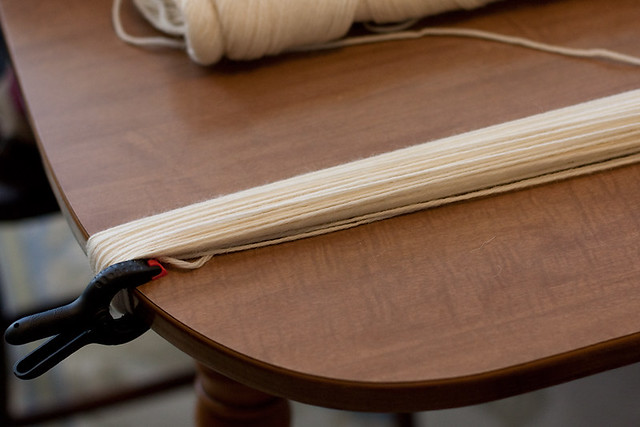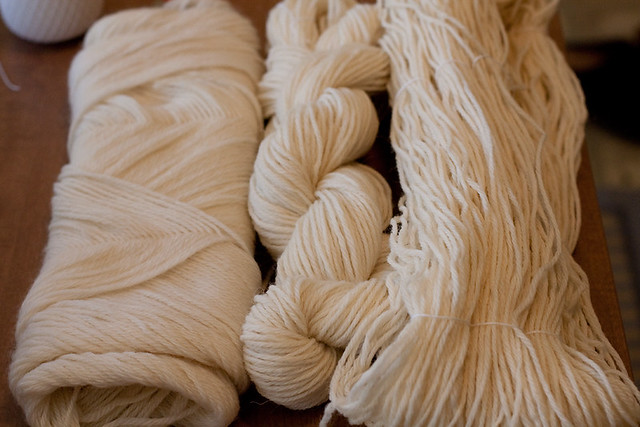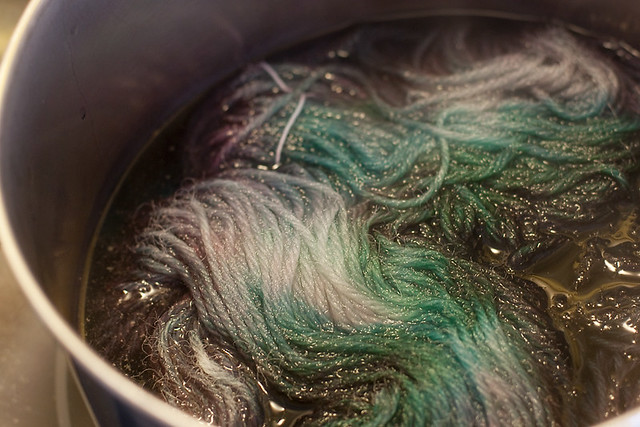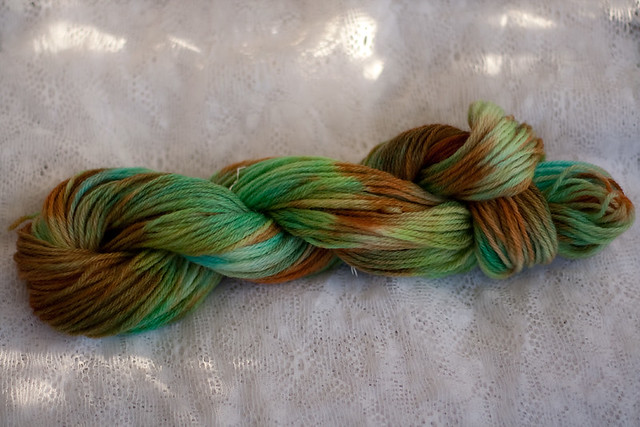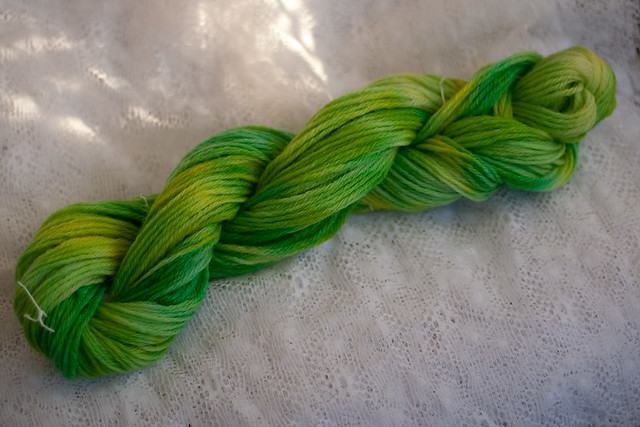Yep, I gave in to temptation last week (so the wet sheep smell is long gone (g)) and treated myself to some yarn-dyeing! (After a draining, depressing Tuesday, I needed some fun.)
I started with a skein of Lion Brand Fishermen's Wool in "Natural". I know that this yarn isn't considered of the highest quality by many, but it has its good points. It's readily available in even big-box craft stores (where you can use a coupon to get it at an affordable price). The yardage is fantastic-- 465 yards of worsted weight per skein. And it's 100% wool, which is perfect for playing around with dye. It's not superwash (which means you can't just toss it it the washing machine-- hand washing is a must), but that makes it good for felting, if you've ever wanted to try that. It's not the softest yarn ever and may be a little scratchy against the most sensitive skin, but for something like hats or outerwear, I think it's just fine.
So, with such a large skein (and my wish to try out multiple colorways), the first order of business was to divide it into hanks. (Actually, you'd need to hank it even if you wanted to dye it all the same color. The liquid dye needs to be able to reach into all the crevices if you want it all dyed.)
I did the first hank in the method I was already familiar with-- wrapping it around the back of a chair. Ideally, you use a chair with a "wrap" of about 36 inches, so you can count out the yards as you go. (For future reference: The closest to 36" I have is 34.5 inches. To get about 155 yards in a hank, I need to wrap the chair about 161.7 times. (g) But then I end up wrapping it too tightly, so it probably turns out a little shy of 155 yards, anyway...)
For the other two hanks, I tried something different. To get longer wraps-- something similar to what you get in store-bought/professional hanks of yarn-- I wrapped around the end of our breakfast room table. I measured at a certain point and put tape to mark where I wanted to wrap. Because the corners of the table are rounded, I needed to do something to prevent the wrapped yarn from popping off the table. A couple of tiny plastic clamps worked well. Then I calculated how many wraps I needed (about 72.5 wraps at that point of our table-- 77" per wrap-- gave me the desired 155-yard hank), and I started wrapping.
(Don't forget to tie each hank of yarn in at least a few places to prevent a hugely tangled mess! It's an extremely important step. I use white cotton crochet thread. A ball of the stuff lasts forever, and because the cotton won't accept much-- if any-- of the dye, it remains easy to see even after dyeing.)
The next photo shows (from left to right) one third of the yarn still in the skein, one third in the long-wrap hank (after twisting it until it wraps around itself), and one third in the loose, short-wrap hank. I'm not sure yet which style of wrapping I prefer for dyeing, but I do love the way the long-wrap hank looks-- so fancy, all twisted up like that. ;o)
Then I soaked the yarn in water (with a dash of vinegar)-- not for hours as some people do, because I was too impatient. If I plan far enough ahead, next time, I'll try to soak longer. (Honestly, though, for me, this is more about flying by the seat of my pants and experimenting than anything else.)
Speaking of experimenting, I decided I wanted my first hank (the short-wrap one) to be "broken black". If you don't know about "broken black", you can google it or look around in certain Ravelry forums (such as "What a Kool Way to Dye") and find a wealth of information. (Here's one interesting blog entry.)
Basically, there are multiple colors combined in certain food dyes to achieve the desired color-- black included. By using different concentrations of vinegar (at different points in the dyeing) you can cause the black color to "break" into some of those different colors-- purple, green, teal, pink... It seems to be a bit unpredictable, but if you're a little scientific and persistent, you can exercise a certain degree of control over the results.
I think I accidentally broke a food dye, back when I first tried dyeing. It was a pastel blue, I think, that must've had some red #3, which is known for separating from the rest of the colors in food dyes. Anyway, I really loved the way that yarn turned out, so I decided to just wing it again. I put a small glob of black Wilton's food coloring into a pot of 3 parts water, 1 part vinegar, heated it to steaming, and gently dropped in the yarn.
Here it is, simmering:
You can definitely see the teal green in the top yarn-- and you can see a bit of purple coming out in spots, too.
That was all I did to that hank of yarn-- just steamed it a while (letting as much of the dye exhaust as possible), then carefully removed it from the water and let it cool to room temperature. (In retrospect, I wish I'd let it steam even longer. More on that later.)
For the other two hanks of yarn, I put them through multiple dye-baths. I kinda-sorta followed the method demonstrated in this very interesting video (which also shows how to tie and twist hanks of yarn). She dyes twisted hanks, then (carefully, gently) untwists and retwists them (or ties them in loose knots) before dunking in subsequent dye-baths to preserve bits of color from earlier dyeing. It's a process of strategically layering colors.
I didn't do as many steps as demonstrated in the video, because that wasn't the look I was going for-- but I did borrow her method of leaving the yarn twisted the first dunk (to allow the dye to penetrate only so far into the yarn, producing shading and "bright spots")... and the idea of gently tying a "knot" in the hank to protect some of the lightly-tinted yarn from the darker colors.
(I'm very curious to see how my first attempts look when knitted up!)
Now I come to the less joyful part of my tale. ;o)
I suspect I may not have let the yarn steam long enough. I'm not sure-- but I did have some issues when it came time to rinse and hang to dry.
At least two of my colorways bled a little during rinsing, which is not unheard-of (though I don't recall having much bleeding in my earlier attempts at dyeing).
After thoroughly rinsing (and squeezing most of the water from) the broken black, I hung it in the shower, only to notice soon after that it was dripping colorful drops of water. (Not a good sign.) So back for more rinsing it went. I thought I had it all, at that point, but when I rolled it in an old towel (to press out more moisture), it left a couple of pink stains on the towel! Argh! I gave up and hung it up to dry, anyway. (g)
The green (which you'll see in a moment) was still bleeding a very slight yellowish/greenish tinge into the water even after several rinses. I was tired by that time and decided it was good enough, because I've had store-bought sweaters (and jeans) that have bled more than that. Still, I wonder if I didn't let it steam long enough or at a high enough temperature... Or didn't use enough vinegar... Or...?
I ought to read up on yarn-dyeing a little more before my next attempt, but I think this batch of yarn will be ok. After I knit it up, I may do something to further set the colors. If nothing else, I can let it steam in a mixture of water and vinegar, followed by another wash and rinse before blocking. That ought to do the trick.
Ok, the worrisome stuff is past. Time for gratuitous yarn photos! ;o)
Beauty is in the eye of the beholder-- and maybe these are yarns that only the dyer could love (g)-- but I'm already looking forward to seeing them knit! I already have plans for two of them.
Tundra? Ice Cavern?
Canyon River? Rainforest? Patina?
Majolica? Lettuce? (Romaine? ;o)) Ribbit? (g)
(There are more photos on my Flickr photostream, if anyone's interested.)
I started with a skein of Lion Brand Fishermen's Wool in "Natural". I know that this yarn isn't considered of the highest quality by many, but it has its good points. It's readily available in even big-box craft stores (where you can use a coupon to get it at an affordable price). The yardage is fantastic-- 465 yards of worsted weight per skein. And it's 100% wool, which is perfect for playing around with dye. It's not superwash (which means you can't just toss it it the washing machine-- hand washing is a must), but that makes it good for felting, if you've ever wanted to try that. It's not the softest yarn ever and may be a little scratchy against the most sensitive skin, but for something like hats or outerwear, I think it's just fine.
So, with such a large skein (and my wish to try out multiple colorways), the first order of business was to divide it into hanks. (Actually, you'd need to hank it even if you wanted to dye it all the same color. The liquid dye needs to be able to reach into all the crevices if you want it all dyed.)
I did the first hank in the method I was already familiar with-- wrapping it around the back of a chair. Ideally, you use a chair with a "wrap" of about 36 inches, so you can count out the yards as you go. (For future reference: The closest to 36" I have is 34.5 inches. To get about 155 yards in a hank, I need to wrap the chair about 161.7 times. (g) But then I end up wrapping it too tightly, so it probably turns out a little shy of 155 yards, anyway...)
For the other two hanks, I tried something different. To get longer wraps-- something similar to what you get in store-bought/professional hanks of yarn-- I wrapped around the end of our breakfast room table. I measured at a certain point and put tape to mark where I wanted to wrap. Because the corners of the table are rounded, I needed to do something to prevent the wrapped yarn from popping off the table. A couple of tiny plastic clamps worked well. Then I calculated how many wraps I needed (about 72.5 wraps at that point of our table-- 77" per wrap-- gave me the desired 155-yard hank), and I started wrapping.
(Don't forget to tie each hank of yarn in at least a few places to prevent a hugely tangled mess! It's an extremely important step. I use white cotton crochet thread. A ball of the stuff lasts forever, and because the cotton won't accept much-- if any-- of the dye, it remains easy to see even after dyeing.)
The next photo shows (from left to right) one third of the yarn still in the skein, one third in the long-wrap hank (after twisting it until it wraps around itself), and one third in the loose, short-wrap hank. I'm not sure yet which style of wrapping I prefer for dyeing, but I do love the way the long-wrap hank looks-- so fancy, all twisted up like that. ;o)
Then I soaked the yarn in water (with a dash of vinegar)-- not for hours as some people do, because I was too impatient. If I plan far enough ahead, next time, I'll try to soak longer. (Honestly, though, for me, this is more about flying by the seat of my pants and experimenting than anything else.)
Speaking of experimenting, I decided I wanted my first hank (the short-wrap one) to be "broken black". If you don't know about "broken black", you can google it or look around in certain Ravelry forums (such as "What a Kool Way to Dye") and find a wealth of information. (Here's one interesting blog entry.)
Basically, there are multiple colors combined in certain food dyes to achieve the desired color-- black included. By using different concentrations of vinegar (at different points in the dyeing) you can cause the black color to "break" into some of those different colors-- purple, green, teal, pink... It seems to be a bit unpredictable, but if you're a little scientific and persistent, you can exercise a certain degree of control over the results.
I think I accidentally broke a food dye, back when I first tried dyeing. It was a pastel blue, I think, that must've had some red #3, which is known for separating from the rest of the colors in food dyes. Anyway, I really loved the way that yarn turned out, so I decided to just wing it again. I put a small glob of black Wilton's food coloring into a pot of 3 parts water, 1 part vinegar, heated it to steaming, and gently dropped in the yarn.
Here it is, simmering:
You can definitely see the teal green in the top yarn-- and you can see a bit of purple coming out in spots, too.
That was all I did to that hank of yarn-- just steamed it a while (letting as much of the dye exhaust as possible), then carefully removed it from the water and let it cool to room temperature. (In retrospect, I wish I'd let it steam even longer. More on that later.)
For the other two hanks of yarn, I put them through multiple dye-baths. I kinda-sorta followed the method demonstrated in this very interesting video (which also shows how to tie and twist hanks of yarn). She dyes twisted hanks, then (carefully, gently) untwists and retwists them (or ties them in loose knots) before dunking in subsequent dye-baths to preserve bits of color from earlier dyeing. It's a process of strategically layering colors.
I didn't do as many steps as demonstrated in the video, because that wasn't the look I was going for-- but I did borrow her method of leaving the yarn twisted the first dunk (to allow the dye to penetrate only so far into the yarn, producing shading and "bright spots")... and the idea of gently tying a "knot" in the hank to protect some of the lightly-tinted yarn from the darker colors.
(I'm very curious to see how my first attempts look when knitted up!)
Now I come to the less joyful part of my tale. ;o)
I suspect I may not have let the yarn steam long enough. I'm not sure-- but I did have some issues when it came time to rinse and hang to dry.
At least two of my colorways bled a little during rinsing, which is not unheard-of (though I don't recall having much bleeding in my earlier attempts at dyeing).
After thoroughly rinsing (and squeezing most of the water from) the broken black, I hung it in the shower, only to notice soon after that it was dripping colorful drops of water. (Not a good sign.) So back for more rinsing it went. I thought I had it all, at that point, but when I rolled it in an old towel (to press out more moisture), it left a couple of pink stains on the towel! Argh! I gave up and hung it up to dry, anyway. (g)
The green (which you'll see in a moment) was still bleeding a very slight yellowish/greenish tinge into the water even after several rinses. I was tired by that time and decided it was good enough, because I've had store-bought sweaters (and jeans) that have bled more than that. Still, I wonder if I didn't let it steam long enough or at a high enough temperature... Or didn't use enough vinegar... Or...?
I ought to read up on yarn-dyeing a little more before my next attempt, but I think this batch of yarn will be ok. After I knit it up, I may do something to further set the colors. If nothing else, I can let it steam in a mixture of water and vinegar, followed by another wash and rinse before blocking. That ought to do the trick.
Ok, the worrisome stuff is past. Time for gratuitous yarn photos! ;o)
Beauty is in the eye of the beholder-- and maybe these are yarns that only the dyer could love (g)-- but I'm already looking forward to seeing them knit! I already have plans for two of them.
Tundra? Ice Cavern?
Canyon River? Rainforest? Patina?
Majolica? Lettuce? (Romaine? ;o)) Ribbit? (g)
(There are more photos on my Flickr photostream, if anyone's interested.)
